tow bar FORD RANGER 2003 2.G Owners Manual
[x] Cancel search | Manufacturer: FORD, Model Year: 2003, Model line: RANGER, Model: FORD RANGER 2003 2.GPages: 248, PDF Size: 2.53 MB
Page 57 of 248
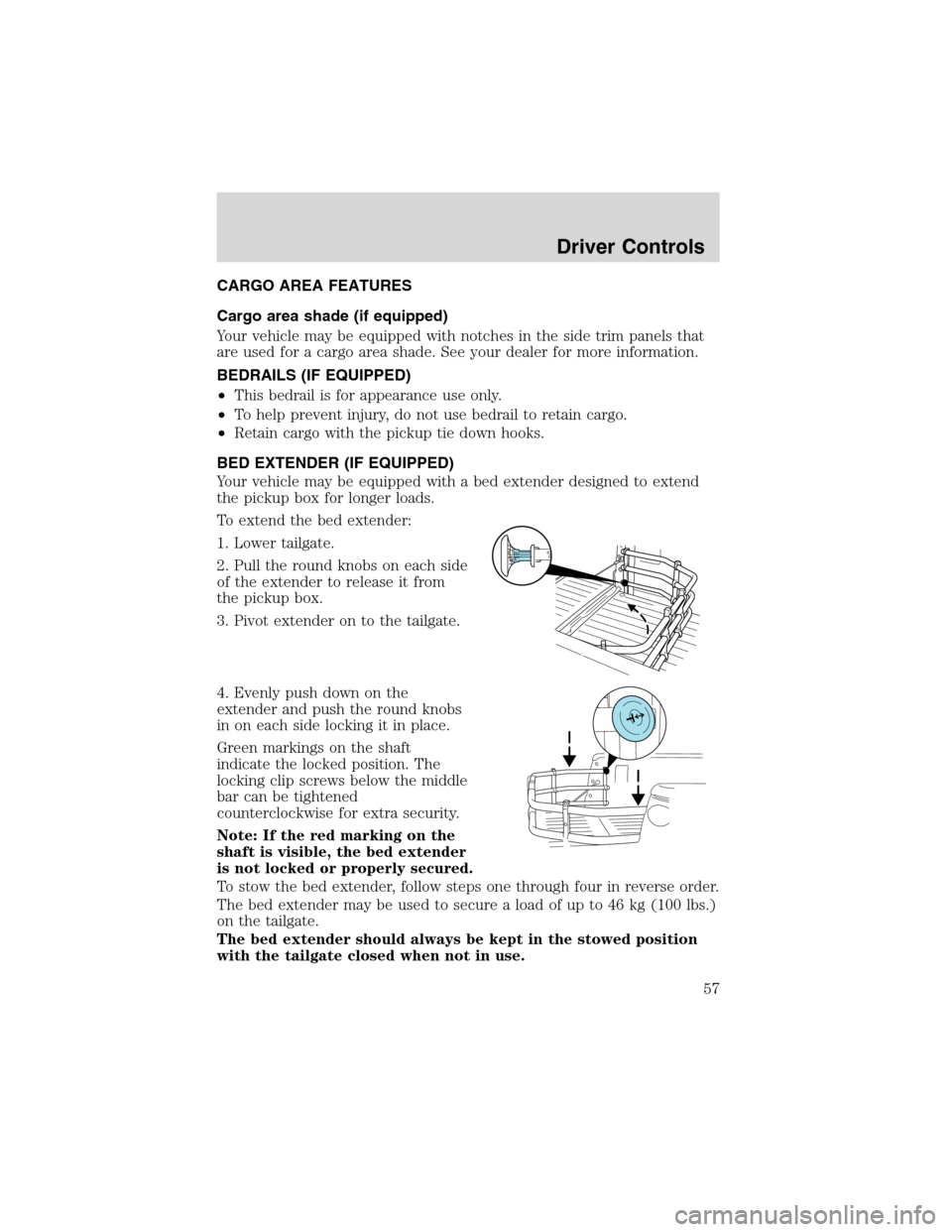
CARGO AREA FEATURES
Cargo area shade (if equipped)
Your vehicle may be equipped with notches in the side trim panels that
are used for a cargo area shade. See your dealer for more information.
BEDRAILS (IF EQUIPPED)
•This bedrail is for appearance use only.
•To help prevent injury, do not use bedrail to retain cargo.
•Retain cargo with the pickup tie down hooks.
BED EXTENDER (IF EQUIPPED)
Your vehicle may be equipped with a bed extender designed to extend
the pickup box for longer loads.
To extend the bed extender:
1. Lower tailgate.
2. Pull the round knobs on each side
of the extender to release it from
the pickup box.
3. Pivot extender on to the tailgate.
4. Evenly push down on the
extender and push the round knobs
in on each side locking it in place.
Green markings on the shaft
indicate the locked position. The
locking clip screws below the middle
bar can be tightened
counterclockwise for extra security.
Note: If the red marking on the
shaft is visible, the bed extender
is not locked or properly secured.
To stow the bed extender, follow steps one through four in reverse order.
The bed extender may be used to secure a load of up to 46 kg (100 lbs.)
on the tailgate.
The bed extender should always be kept in the stowed position
with the tailgate closed when not in use.
Driver Controls
57
Page 58 of 248
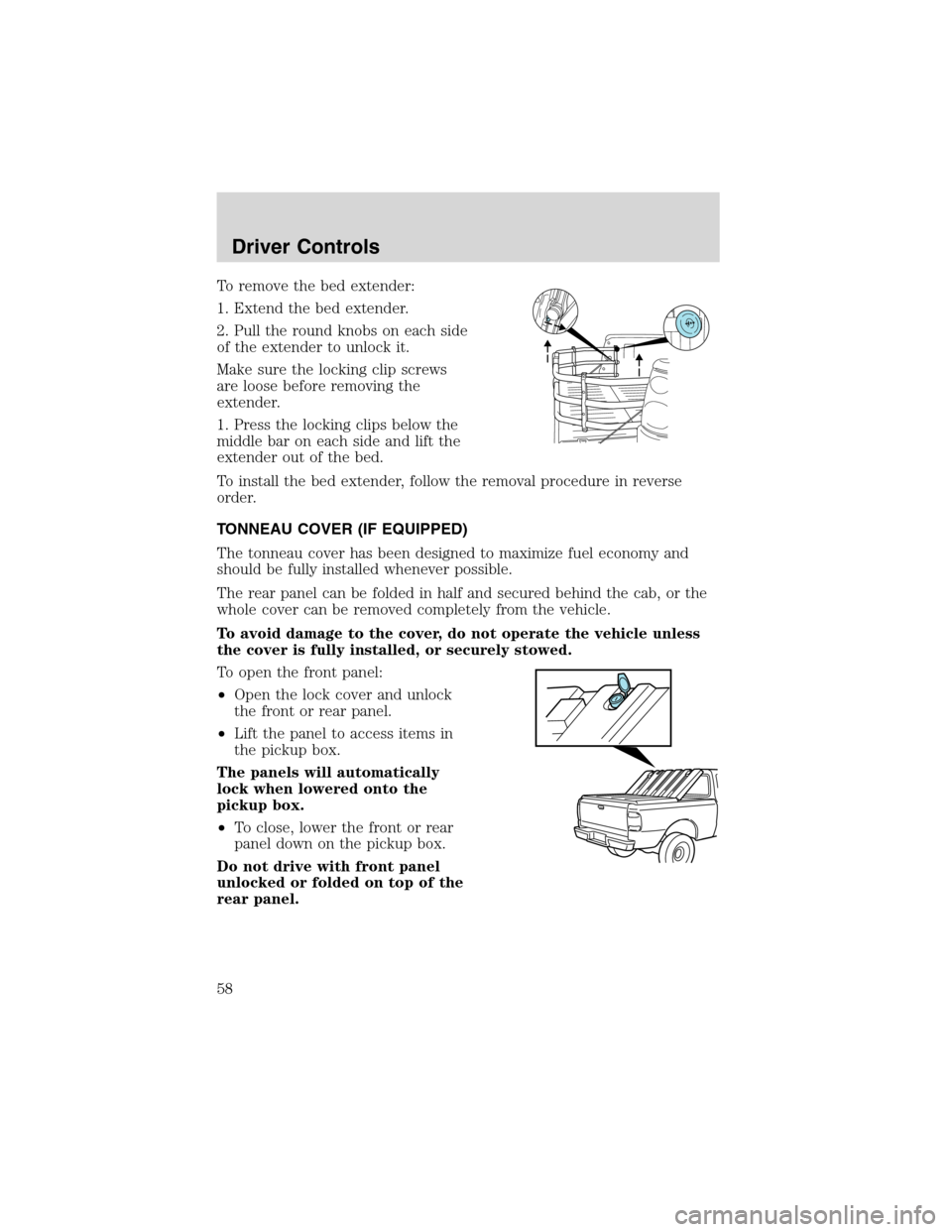
To remove the bed extender:
1. Extend the bed extender.
2. Pull the round knobs on each side
of the extender to unlock it.
Make sure the locking clip screws
are loose before removing the
extender.
1. Press the locking clips below the
middle bar on each side and lift the
extender out of the bed.
To install the bed extender, follow the removal procedure in reverse
order.
TONNEAU COVER (IF EQUIPPED)
The tonneau cover has been designed to maximize fuel economy and
should be fully installed whenever possible.
The rear panel can be folded in half and secured behind the cab, or the
whole cover can be removed completely from the vehicle.
To avoid damage to the cover, do not operate the vehicle unless
the cover is fully installed, or securely stowed.
To open the front panel:
•Open the lock cover and unlock
the front or rear panel.
•Lift the panel to access items in
the pickup box.
The panels will automatically
lock when lowered onto the
pickup box.
•To close, lower the front or rear
panel down on the pickup box.
Do not drive with front panel
unlocked or folded on top of the
rear panel.
Driver Controls
58
Page 72 of 248
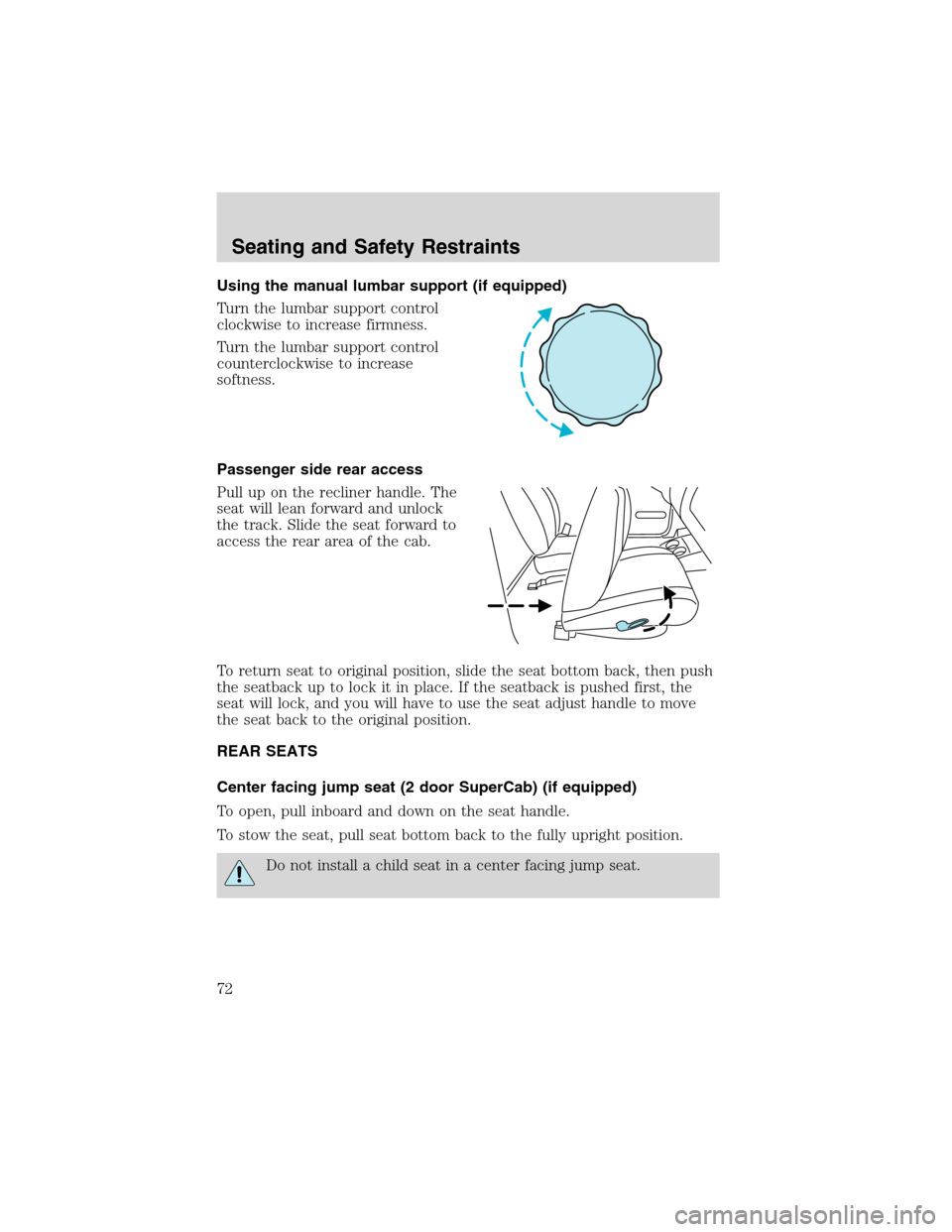
Using the manual lumbar support (if equipped)
Turn the lumbar support control
clockwise to increase firmness.
Turn the lumbar support control
counterclockwise to increase
softness.
Passenger side rear access
Pull up on the recliner handle. The
seat will lean forward and unlock
the track. Slide the seat forward to
access the rear area of the cab.
To return seat to original position, slide the seat bottom back, then push
the seatback up to lock it in place. If the seatback is pushed first, the
seat will lock, and you will have to use the seat adjust handle to move
the seat back to the original position.
REAR SEATS
Center facing jump seat (2 door SuperCab) (if equipped)
To open, pull inboard and down on the seat handle.
To stow the seat, pull seat bottom back to the fully upright position.
Do not install a child seat in a center facing jump seat.
Seating and Safety Restraints
72
Page 134 of 248
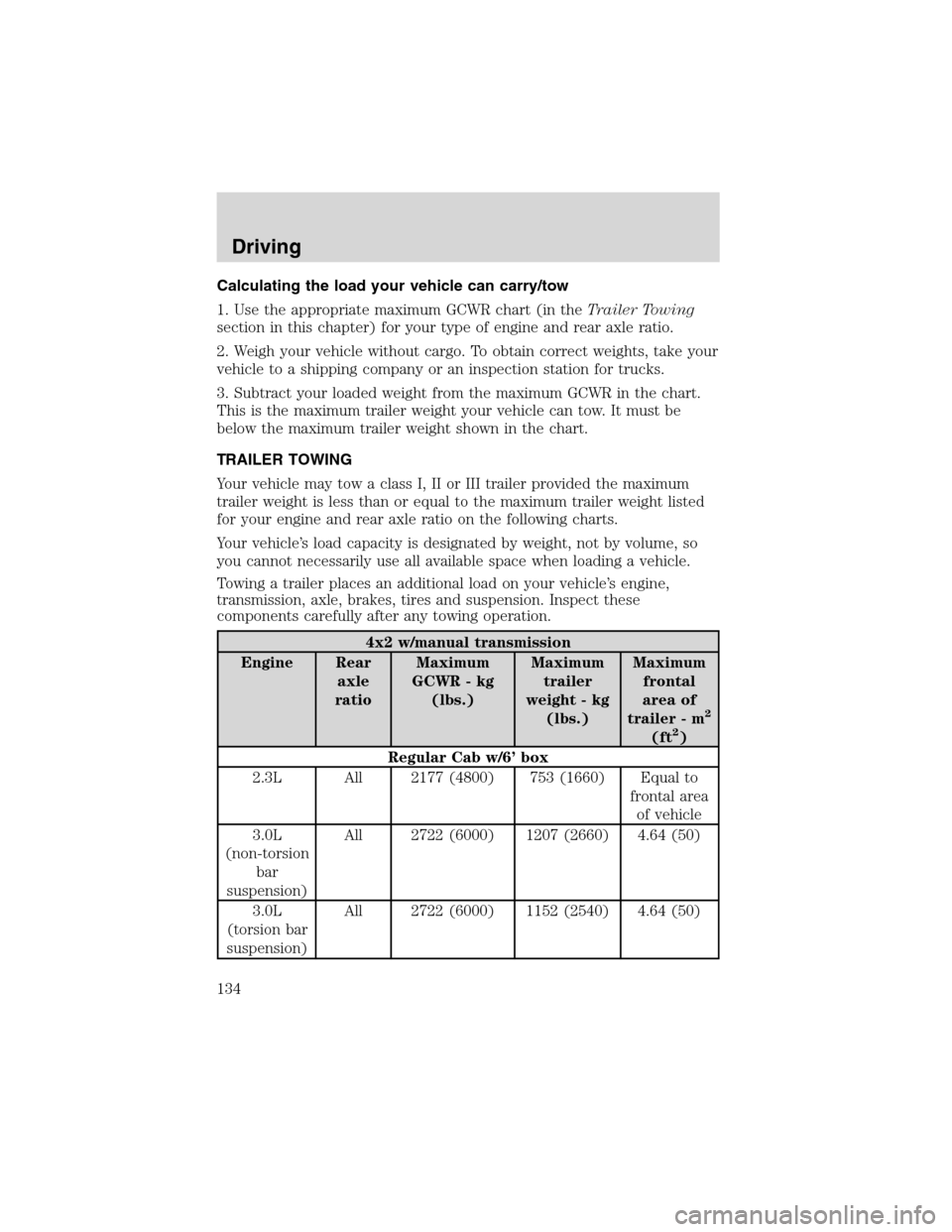
Calculating the load your vehicle can carry/tow
1. Use the appropriate maximum GCWR chart (in theTrailer Towing
section in this chapter) for your type of engine and rear axle ratio.
2. Weigh your vehicle without cargo. To obtain correct weights, take your
vehicle to a shipping company or an inspection station for trucks.
3. Subtract your loaded weight from the maximum GCWR in the chart.
This is the maximum trailer weight your vehicle can tow. It must be
below the maximum trailer weight shown in the chart.
TRAILER TOWING
Your vehicle may tow a class I, II or III trailer provided the maximum
trailer weight is less than or equal to the maximum trailer weight listed
for your engine and rear axle ratio on the following charts.
Your vehicle’s load capacity is designated by weight, not by volume, so
you cannot necessarily use all available space when loading a vehicle.
Towing a trailer places an additional load on your vehicle’s engine,
transmission, axle, brakes, tires and suspension. Inspect these
components carefully after any towing operation.
4x2 w/manual transmission
Engine Rear
axle
ratioMaximum
GCWR - kg
(lbs.)Maximum
trailer
weight - kg
(lbs.)Maximum
frontal
area of
trailer - m
2
(ft2)
Regular Cab w/6’box
2.3L All 2177 (4800) 753 (1660) Equal to
frontal area
of vehicle
3.0L
(non-torsion
bar
suspension)All 2722 (6000) 1207 (2660) 4.64 (50)
3.0L
(torsion bar
suspension)All 2722 (6000) 1152 (2540) 4.64 (50)
Driving
134
Page 136 of 248
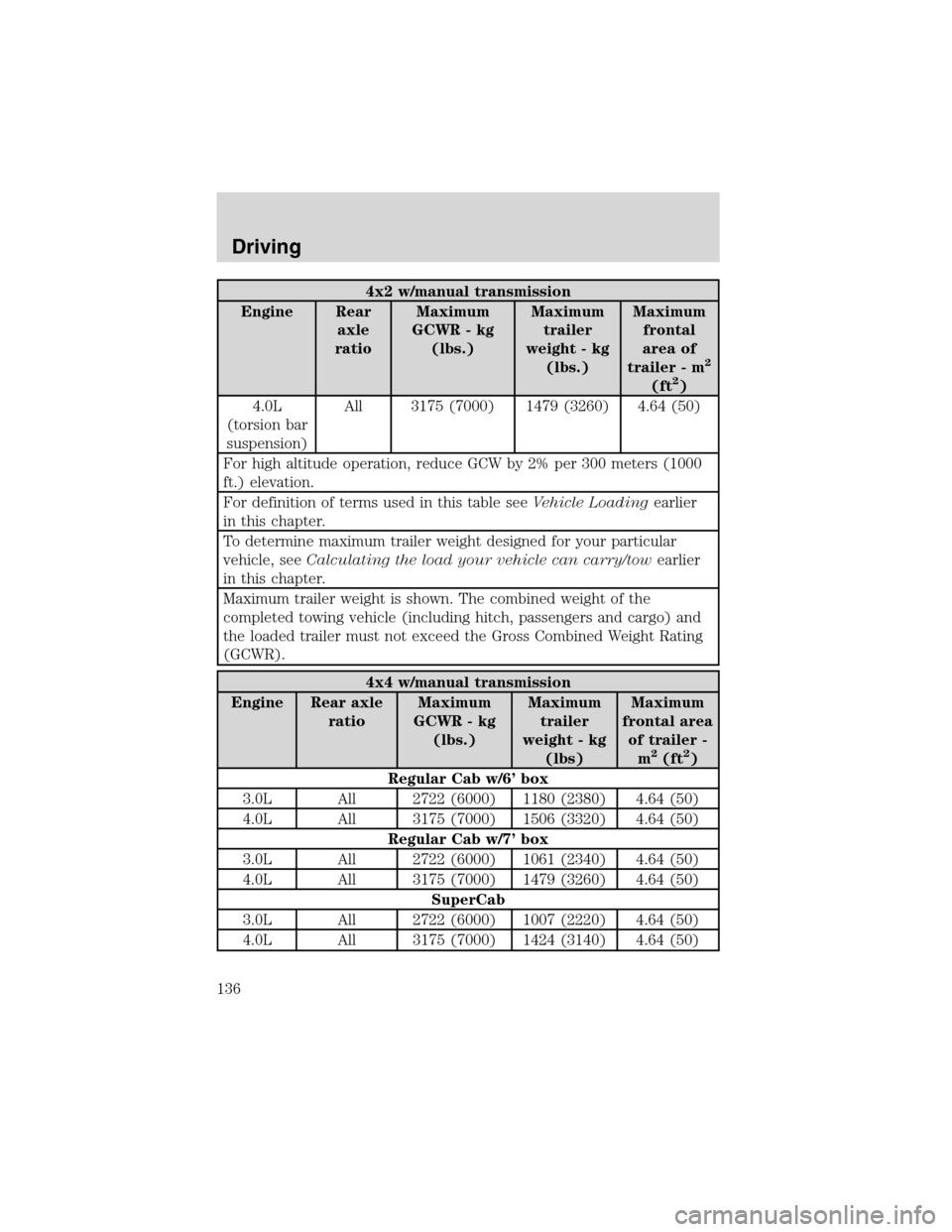
4x2 w/manual transmission
Engine Rear
axle
ratioMaximum
GCWR - kg
(lbs.)Maximum
trailer
weight - kg
(lbs.)Maximum
frontal
area of
trailer - m
2
(ft2)
4.0L
(torsion bar
suspension)All 3175 (7000) 1479 (3260) 4.64 (50)
For high altitude operation, reduce GCW by 2% per 300 meters (1000
ft.) elevation.
For definition of terms used in this table seeVehicle Loadingearlier
in this chapter.
To determine maximum trailer weight designed for your particular
vehicle, seeCalculating the load your vehicle can carry/towearlier
in this chapter.
Maximum trailer weight is shown. The combined weight of the
completed towing vehicle (including hitch, passengers and cargo) and
the loaded trailer must not exceed the Gross Combined Weight Rating
(GCWR).
4x4 w/manual transmission
Engine Rear axle
ratioMaximum
GCWR - kg
(lbs.)Maximum
trailer
weight - kg
(lbs)Maximum
frontal area
of trailer -
m
2(ft2)
Regular Cab w/6’box
3.0L All 2722 (6000) 1180 (2380) 4.64 (50)
4.0L All 3175 (7000) 1506 (3320) 4.64 (50)
Regular Cab w/7’box
3.0L All 2722 (6000) 1061 (2340) 4.64 (50)
4.0L All 3175 (7000) 1479 (3260) 4.64 (50)
SuperCab
3.0L All 2722 (6000) 1007 (2220) 4.64 (50)
4.0L All 3175 (7000) 1424 (3140) 4.64 (50)
Driving
136
Page 137 of 248
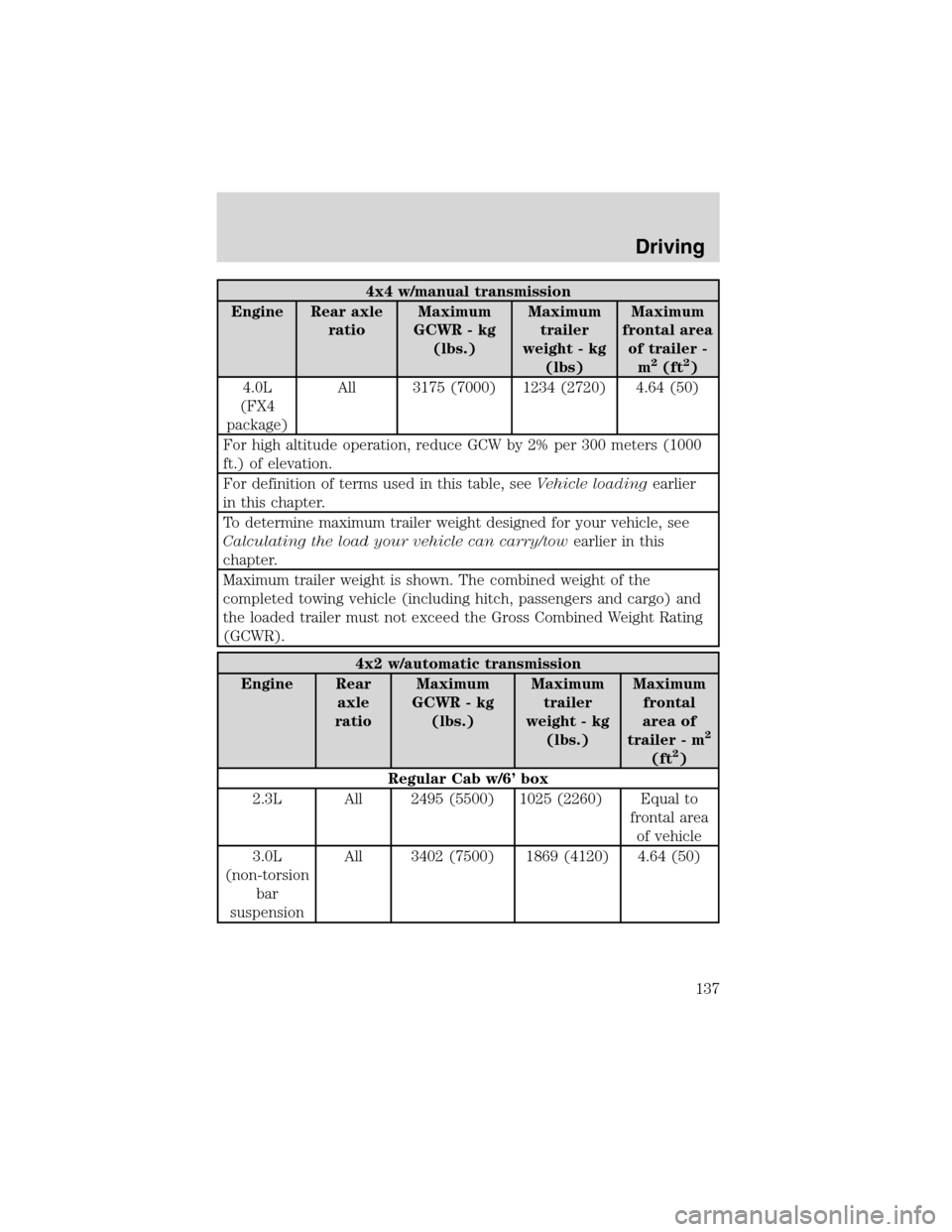
4x4 w/manual transmission
Engine Rear axle
ratioMaximum
GCWR - kg
(lbs.)Maximum
trailer
weight - kg
(lbs)Maximum
frontal area
of trailer -
m
2(ft2)
4.0L
(FX4
package)All 3175 (7000) 1234 (2720) 4.64 (50)
For high altitude operation, reduce GCW by 2% per 300 meters (1000
ft.) of elevation.
For definition of terms used in this table, seeVehicle loadingearlier
in this chapter.
To determine maximum trailer weight designed for your vehicle, see
Calculating the load your vehicle can carry/towearlier in this
chapter.
Maximum trailer weight is shown. The combined weight of the
completed towing vehicle (including hitch, passengers and cargo) and
the loaded trailer must not exceed the Gross Combined Weight Rating
(GCWR).
4x2 w/automatic transmission
Engine Rear
axle
ratioMaximum
GCWR - kg
(lbs.)Maximum
trailer
weight - kg
(lbs.)Maximum
frontal
area of
trailer - m
2
(ft2)
Regular Cab w/6’box
2.3L All 2495 (5500) 1025 (2260) Equal to
frontal area
of vehicle
3.0L
(non-torsion
bar
suspensionAll 3402 (7500) 1869 (4120) 4.64 (50)
Driving
137
Page 139 of 248
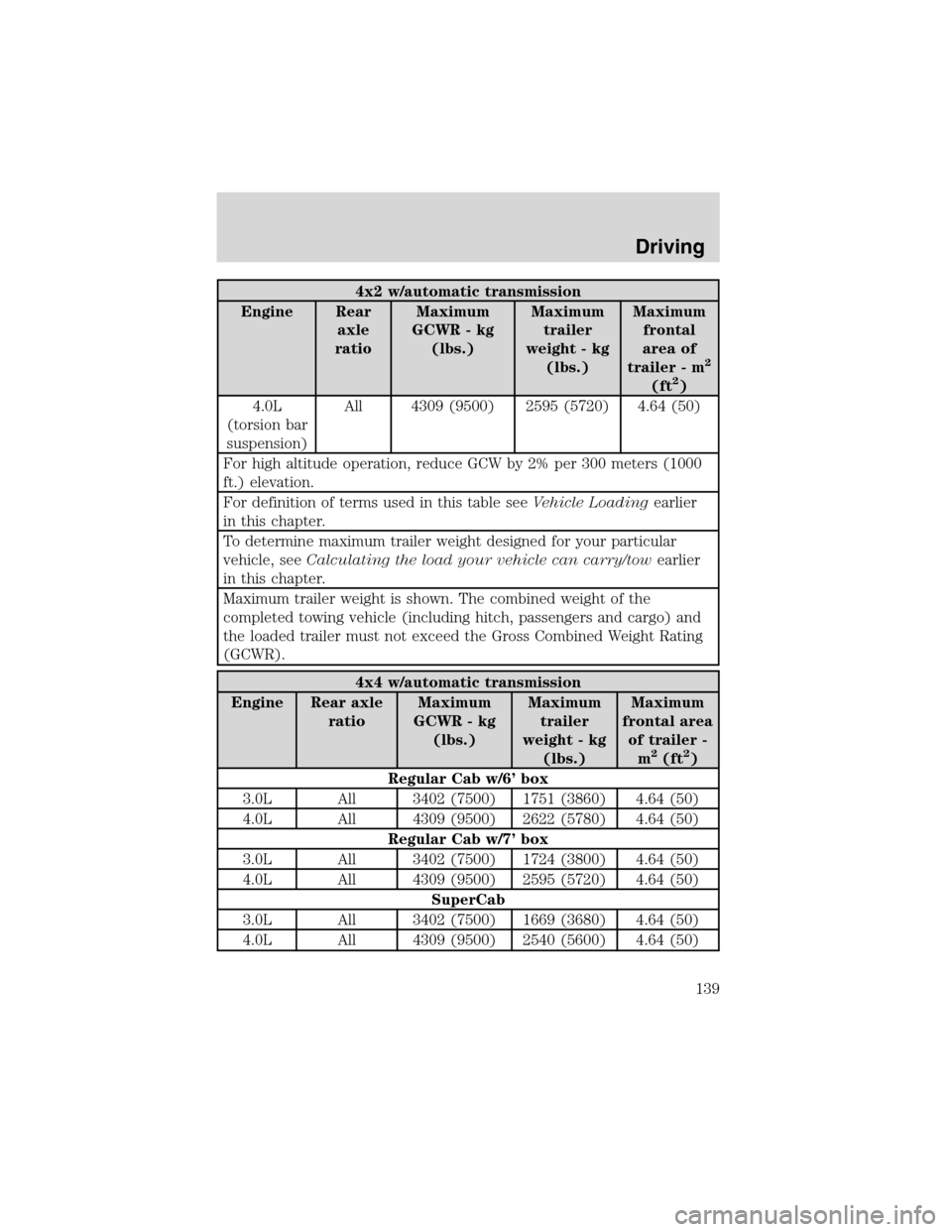
4x2 w/automatic transmission
Engine Rear
axle
ratioMaximum
GCWR - kg
(lbs.)Maximum
trailer
weight - kg
(lbs.)Maximum
frontal
area of
trailer - m
2
(ft2)
4.0L
(torsion bar
suspension)All 4309 (9500) 2595 (5720) 4.64 (50)
For high altitude operation, reduce GCW by 2% per 300 meters (1000
ft.) elevation.
For definition of terms used in this table seeVehicle Loadingearlier
in this chapter.
To determine maximum trailer weight designed for your particular
vehicle, seeCalculating the load your vehicle can carry/towearlier
in this chapter.
Maximum trailer weight is shown. The combined weight of the
completed towing vehicle (including hitch, passengers and cargo) and
the loaded trailer must not exceed the Gross Combined Weight Rating
(GCWR).
4x4 w/automatic transmission
Engine Rear axle
ratioMaximum
GCWR - kg
(lbs.)Maximum
trailer
weight - kg
(lbs.)Maximum
frontal area
of trailer -
m
2(ft2)
Regular Cab w/6’box
3.0L All 3402 (7500) 1751 (3860) 4.64 (50)
4.0L All 4309 (9500) 2622 (5780) 4.64 (50)
Regular Cab w/7’box
3.0L All 3402 (7500) 1724 (3800) 4.64 (50)
4.0L All 4309 (9500) 2595 (5720) 4.64 (50)
SuperCab
3.0L All 3402 (7500) 1669 (3680) 4.64 (50)
4.0L All 4309 (9500) 2540 (5600) 4.64 (50)
Driving
139
Page 214 of 248
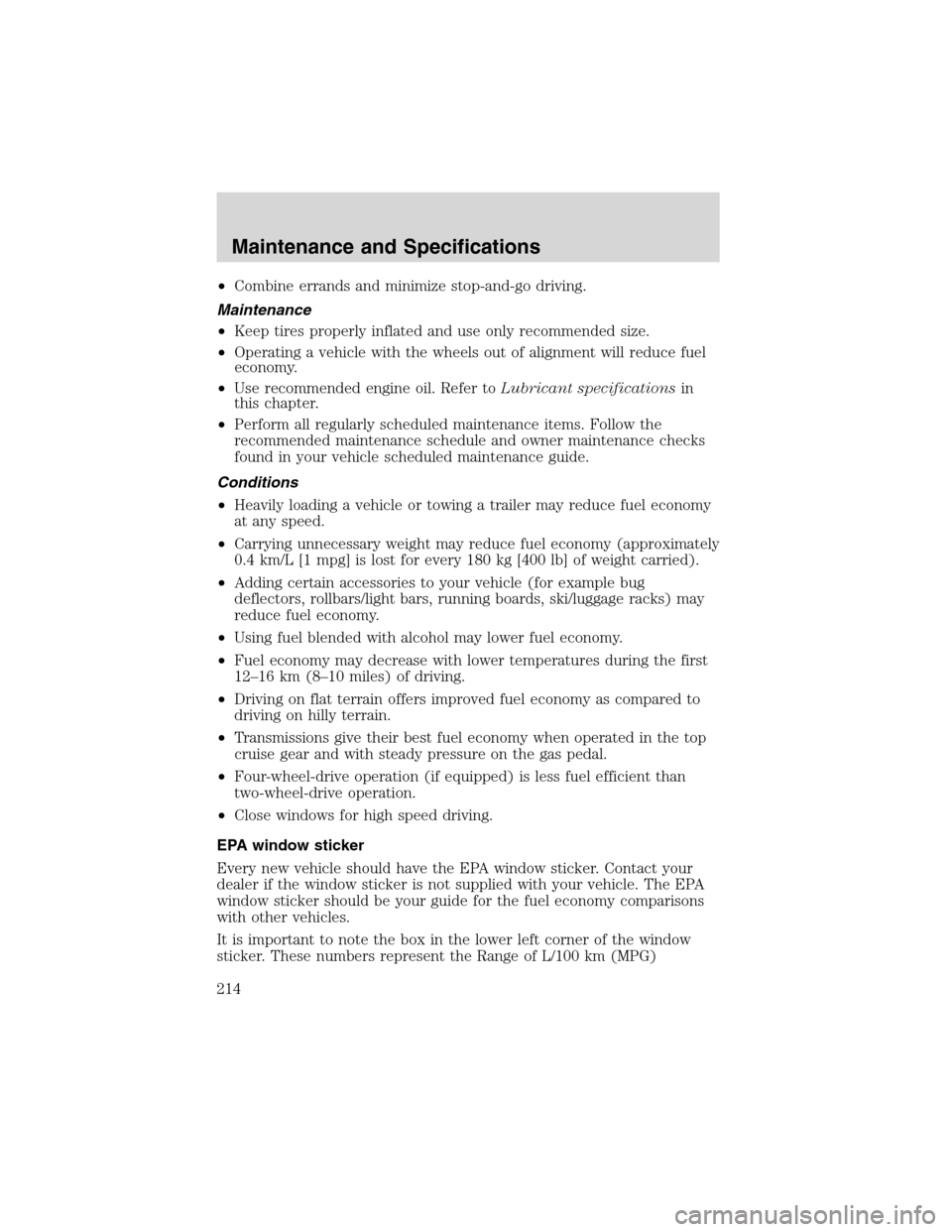
•Combine errands and minimize stop-and-go driving.
Maintenance
•Keep tires properly inflated and use only recommended size.
•Operating a vehicle with the wheels out of alignment will reduce fuel
economy.
•Use recommended engine oil. Refer toLubricant specificationsin
this chapter.
•Perform all regularly scheduled maintenance items. Follow the
recommended maintenance schedule and owner maintenance checks
found in your vehicle scheduled maintenance guide.
Conditions
•Heavily loading a vehicle or towing a trailer may reduce fuel economy
at any speed.
•Carrying unnecessary weight may reduce fuel economy (approximately
0.4 km/L [1 mpg] is lost for every 180 kg [400 lb] of weight carried).
•Adding certain accessories to your vehicle (for example bug
deflectors, rollbars/light bars, running boards, ski/luggage racks) may
reduce fuel economy.
•Using fuel blended with alcohol may lower fuel economy.
•Fuel economy may decrease with lower temperatures during the first
12–16 km (8–10 miles) of driving.
•Driving on flat terrain offers improved fuel economy as compared to
driving on hilly terrain.
•Transmissions give their best fuel economy when operated in the top
cruise gear and with steady pressure on the gas pedal.
•Four-wheel-drive operation (if equipped) is less fuel efficient than
two-wheel-drive operation.
•Close windows for high speed driving.
EPA window sticker
Every new vehicle should have the EPA window sticker. Contact your
dealer if the window sticker is not supplied with your vehicle. The EPA
window sticker should be your guide for the fuel economy comparisons
with other vehicles.
It is important to note the box in the lower left corner of the window
sticker. These numbers represent the Range of L/100 km (MPG)
Maintenance and Specifications
214
Page 246 of 248
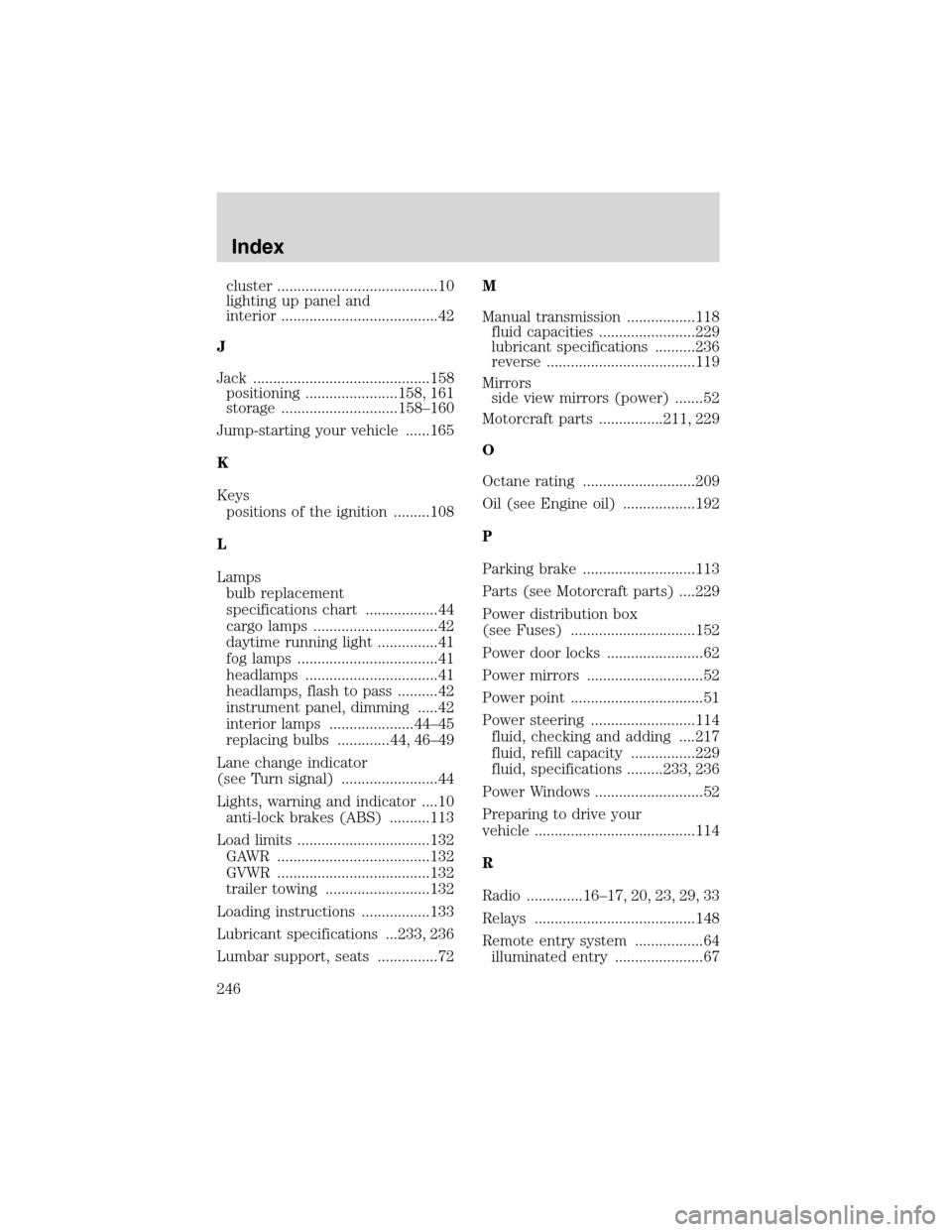
cluster ........................................10
lighting up panel and
interior .......................................42
J
Jack ............................................158
positioning .......................158, 161
storage .............................158–160
Jump-starting your vehicle ......165
K
Keys
positions of the ignition .........108
L
Lamps
bulb replacement
specifications chart ..................44
cargo lamps ...............................42
daytime running light ...............41
fog lamps ...................................41
headlamps .................................41
headlamps, flash to pass ..........42
instrument panel, dimming .....42
interior lamps .....................44–45
replacing bulbs .............44, 46–49
Lane change indicator
(see Turn signal) ........................44
Lights, warning and indicator ....10
anti-lock brakes (ABS) ..........113
Load limits .................................132
GAWR ......................................132
GVWR ......................................132
trailer towing ..........................132
Loading instructions .................133
Lubricant specifications ...233, 236
Lumbar support, seats ...............72M
Manual transmission .................118
fluid capacities ........................229
lubricant specifications ..........236
reverse .....................................119
Mirrors
side view mirrors (power) .......52
Motorcraft parts ................211, 229
O
Octane rating ............................209
Oil (see Engine oil) ..................192
P
Parking brake ............................113
Parts (see Motorcraft parts) ....229
Power distribution box
(see Fuses) ...............................152
Power door locks ........................62
Power mirrors .............................52
Power point .................................51
Power steering ..........................114
fluid, checking and adding ....217
fluid, refill capacity ................229
fluid, specifications .........233, 236
Power Windows ...........................52
Preparing to drive your
vehicle ........................................114
R
Radio ..............16–17, 20, 23, 29, 33
Relays ........................................148
Remote entry system .................64
illuminated entry ......................67
Index
246